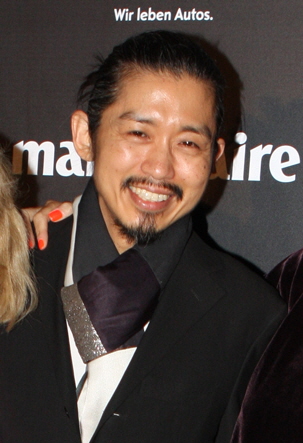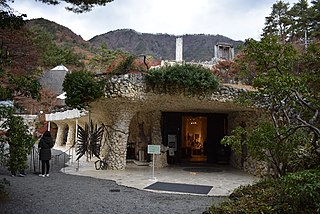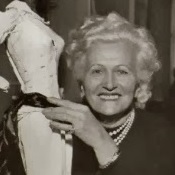Related Research Articles

There are typically two types of clothing worn in Japan: traditional clothing known as Japanese clothing, including the national dress of Japan, the kimono, and Western clothing, which encompasses all else not recognised as either national dress or the dress of another country.
Daniel Hechter is a French-Belgian fashion designer who is sometimes referred to as the inventor of ready-to-wear (prêt-à-porter). He is also known for being the president of Paris Saint-Germain F.C. from 1974 to 1978, having designed the club's famous home shirt.

Akira Isogawa is an Australian contemporary fashion designer.

The Delphos gown is a finely pleated silk dress first created in about 1907 by French designer Henriette Negrin and her husband, Mariano Fortuny y Madrazo (1871–1949). They produced the gowns until about 1950. It was inspired by, and named after, a classical Greek statue, the Charioteer of Delphi. Since the 1970s, these gowns have been desirable and collectable pieces of vintage clothing, with one selling for a world record price of $10,000 in December 2001.

Princess Akiko of Mikasa is a member of the Imperial House of Japan and the elder daughter of Prince Tomohito of Mikasa and Princess Tomohito of Mikasa (Nobuko).

Callot Soeurs was one of the leading fashion design houses of the 1910s and 1920s.

Taffeta is a crisp, smooth, plain woven fabric made from silk, cuprammonium rayons, acetate, or polyester. The word came into Middle English via Old French and Old Italian, which borrowed the Persian word tāfta (تافته), which means "silk" or "linen cloth". As clothing, it is used in ball gowns, wedding dresses, and corsets, and in interior decoration for curtains or wallcovering. It tends to yield a stiff, starched-like cloth that holds its shape better than many other fabrics and does not sag or drape.

Itchiku Kubota (1917–2003) was a Japanese textile artist. He was most famous for reviving and in part reinventing an otherwise lost late 15th- to early 16th-century textile dye technique known as tsujigahana, which became the main focus for much of his life's work. As homage to the original tsujigahana technique and its legacy, he named the technique 'itchiku tsujigahana'.

A wrap dress is generic term for a dress with a front closure formed by wrapping one side across the other, and is fastened at the side or tied at the back. This forms a V-shaped neckline. A faux wrap dress resembles this design, except that it comes already fastened together with no opening in front, but instead is slipped on over the head. A wrap top is a top cut and constructed in the same way as a wrap dress, but without a skirt. The design of wrap-style closure in European garments was the results of the heavy influences of Orientalism which was popular in the 19th century.

Metal corsets are a type of historical corset or bodice made entirely out of metal, usually iron or steel. The metal corset was popularly claimed to have been introduced to France by Catherine de' Medici in the 16th century, although this is now considered a myth. The idea that such garments were worn for fashionable purposes is debatable, with fashion historians now regarding such claims sceptically. Many of the original metal bodices that have survived are now believed to have been intended for medical purposes as orthopaedic support garments and back braces. Such garments were described by the French army surgeon Ambroise Paré in the 16th century as a remedy for the "crookednesse of the Bodie."

Paper clothing describes garments and accessories made from paper or paper substitutes. The earliest known paper clothing was made by the Chinese even before they used paper as a writing medium in the 2nd century CE. Paper clothing, usually made from washi paper, was developed by the Chinese through the centuries, the craft spreading through Asia, until it reached Japan. From the 10th century onwards, Japanese craftspeople produced paper garments called kamiko. Kamiko became a traditional Japanese craft of Shiroishi, Miyagi, carried out to a very high standard and skill during the Edo period. The practice began to die out in the late 19th century, before being revived in the mid-20th century. In the early 20th century, German and Austrian manufacturers began producing "ersatz" paper cloth and clothing in response to wool shortages caused by World War I. While there was a brief period of interest in paper suits and garments during the early 1920s, this did not catch on as despite paper's economic advantages, traditional woven cloth was widely preferred. However, some fancy dress costumes, hats, and fashionable accessories were made from crêpe paper during the early 20th century and in response to resource shortages before and during World War II.

Marie-Louise Bruyère, mostly known as Madame Bruyère, or simply as Bruyère, was a French fashion designer of the 1930s, 1940s and 1950s, operating out of Paris, and importing her fashion lines abroad.

Babani, founded in Paris in 1894 by Vitaldi Babani, was a fashion house based on the Boulevard Haussmann specialising in imported exotic goods, including artworks and handicrafts, and from the 1910s onwards, original garments inspired by their imported merchandise. The business closed in 1940.

Warp printing is a fabric production method which combines textile printing and weaving to create a distinctively patterned fabric, usually in silk. The warp threads of the fabric are printed before weaving to create a softly blurred, vague pastel-coloured pattern. It was particularly fashionable in the eighteenth century for summer wear.

"Princess line" or "princess dress" describes a woman's fitted dress or other garment cut in long panels without a horizontal join or separation at the waist. Instead of relying on darts to shape the garment, the fit is achieved with long seams and shaped pattern pieces. A rarely used alternative name for the Princess line was French-dart-line dress.

A visite is a specific type of woman's outer garment similar to a mantle or wrap. It was particularly popular in the late 19th century, being specifically designed to accommodate the then fashionable bustle. The visite replaced the huge shawls that had previously been worn over large crinoline skirts, combining shawl and coat elements, and was even on occasion made using shawls that were valuable but no longer fashionable.
Andrew John Bolton is a British museum curator and current head curator of the Anna Wintour Costume Center at the Metropolitan Museum of Art in New York City.

Yoshiko Iwamoto Wada is a Japanese textile artist, curator, art historian, scholar, professor, and author. She has received international recognition for her scholarship and expertise in the field of textile art. In 2010, she was named a "Distinguished Craft Educator - Master of Medium" by the James Renwick Alliance of the Smithsonian Institution, who stated: "she is single-handedly responsible for introducing the art of Japanese shibori to this country". In 2016 she received the George Hewitt Myers Award for Lifetime Achievement.
Mathilde Flögl was an Austrian artist and designer. She worked in several different mediums including textiles, glass, and paint. Flögl was also a member of the Wiener Werkstätte, literally translated to the Vienna Workshops. This group was part of the Arts and Crafts movement dedicated to elegance, utility, and appropriateness. They aimed to refine art and expand it to all fields of life. Flögl was very active in this group, she participated in most of the major Wiener Werkstätte exhibitions. Currently, the Viennese Museum of Applied Arts houses over 1,600 of Flögl's works from when she was involved with the Wiener Werkstätte. Among these are many independent works and collaborations with other individuals in the group. Notable members of the Wiener Werkstätte include two of its founders Josef Hoffman and Koloman Moser as well as Gustav Klimt, among others. For the group's 25th anniversary, Flögl amassed, arranged, wrote, and published, The Wiener Werkstatte, 1903-1928: The Evolution of the Modern Applied Arts. The book itself was a work of art using elaborate materials and decoration in its pages.

Camp: Notes on Fashion was the 2019 high fashion art exhibition of the Anna Wintour Costume Center, a wing of the Metropolitan Museum of Art in New York that houses the collection of the Costume Institute.
References
- 1 2 3 "Akiko Fukai". Designers & Books. Retrieved 2019-11-21.
- 1 2 3 Fraser, Margie (2014-11-06). "Akiko Fukai on the evolution of Japanese fashion". Vogue Australia. Retrieved 2019-11-21.
- ↑ "Akiko Fukai's Japanese Fashion: Interview with Alison Moloney, Fashion Advisor to the British Council". Dazed. 2011-04-11. Retrieved 2019-11-21.
- ↑ Akiko Fukai Live at the Textile Museum of Canada, April 22, 2014, retrieved 2019-11-21
- ↑ Battersby, Matilda (2010-10-06). "Future Beauty - 30 years of Japanese fashion" . The Independent. Archived from the original on 2017-06-05. Retrieved 2019-11-22.
- ↑ Etherington, Rosee (2010-10-19). "Future Beauty: 30 Years of Japanese Fashion at the Barbican". Dezeen. Retrieved 2019-11-22.
- ↑ Politanoff, Evelyne (2013-06-27). "Future Beauty: 30 Years of Japanese Fashion". HuffPost. Retrieved 2019-11-22.
- ↑ Fukai, Akiko. "Japonism in Fashion" (PDF). Amanda Mayer Stinchecum (translator) – via Kyoto Fashion Institute.
{{cite journal}}: Cite journal requires|journal=(help) - ↑ "Akiko Fukai Bestows Knowledge". Fashion School Daily. 2010-03-15. Retrieved 2019-11-21.